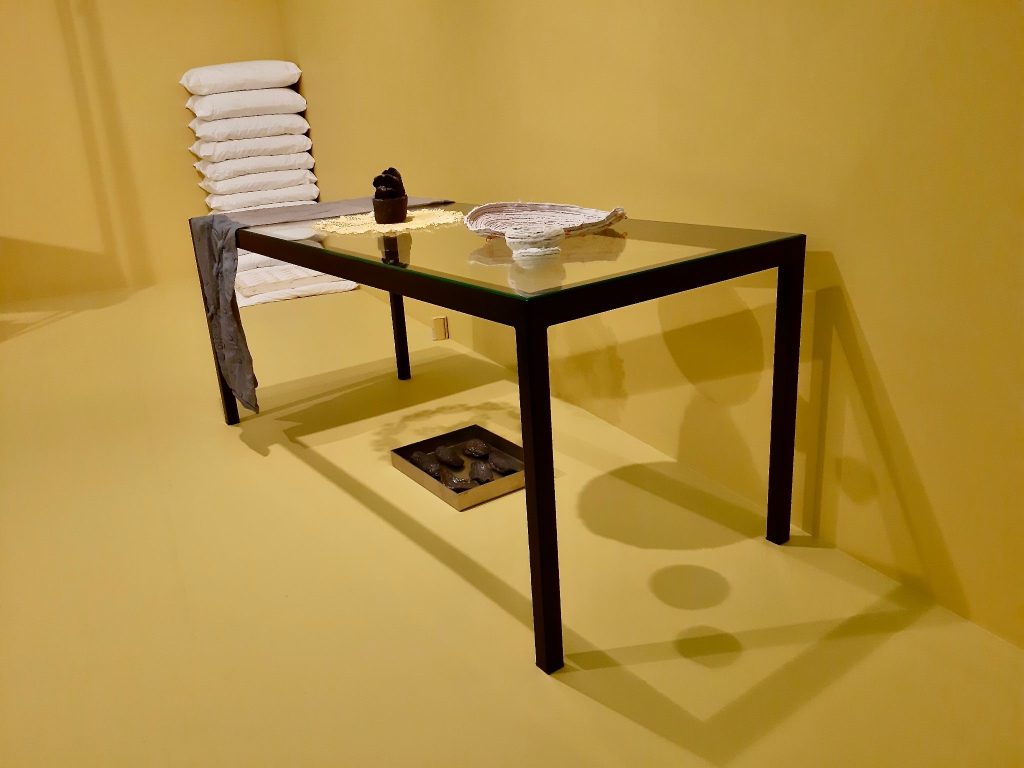TURNER PRIZE 2022
Heather Phillipson, Ingrid Pollard, Veronica Ryan, Sin Wai Kin
Tate Liverpool 20th October 2022 – 23rd March 2023
The latest Turner Prize Exhibition is a medley of emotional connection. Heather Phillipson Ingrid Pollard, Veronica Ryan, and Sin Wai Kin explore the bonds we form with ideas and how these incorporeal acts are made manifest. History, gender, memory, and experience are pulled into the gallery space. Thematically, they harmonise, but each artist presents such a distinctive visual style that every sequence in the exhibition feels fresh.
Heather Phillipson opens the show with ‘RUPTURE NO 6: biting the blowtorched peach’. It is a sensory symphony, combining audio, visual, and sculptural pieces to change the gallery space into a dreamlike landscape. The piece occupies two rooms; the first uses rows of screens, projected audio, and harsh red lighting to create a dramatic atmosphere. The next room is a softer scene, with dusty blues and rich oranges illuminating the space, accompanied by the constant movement of turbine-like sculptural pieces, projections, and hanging headphones. One is struck by the precision of the work; the two rooms complement each other while remaining distinct.
Simple acts such as projecting overlaid audio through speakers to isolating sounds and playing them through a series of suspended headphones are significant distinctions between the space, allowing the audience to define how that space is experienced.
From here, the audience moves from experience to memory with the work of Veronica Ryan. Along a series of sculptures, we see the familiar and the foreign blended into objects that defy simple interpretation. Displayed along various shelves, layers, and platforms, the pieces bring to mind the familiarity of bookshelves and display cabinets, with the yellow walls reinforcing the calming intimacy. Yet the separation of groups of sculptures and the neatness of their presentation suggests a more clinical outlook, a museum collection haunted by the loss of the emotion and physicality that created it. It’s this contradiction that is so intriguing, resonating with the complexity of lived experience and how one projects their understanding of the world onto the inanimate.
Sin Wei Kin’s work follows, interrogating the imprints of consciousness on our perception of the self. Using drag and video work, they reflect on how our bodies have become vessels for the perception of others. We first see Sim Wei Kim as a series of personas across video and prints. Caught between the need for individuality and uniformity, these pieces highlight the uncomfortable space where objectification overcomes identity. This is further explored in ‘A Dream of Wholeness in Parts’, a film showing a living being split into two parts, each seeking to understand the other part of themselves, displayed alongside wipes with the imprint of their makeup. The isolation inherent in the commodification of queer identities is brought to the forefront; this piece is uncompromising in its honesty while retaining its emotional connection to an audience who may not be familiar with these issues.
The exhibition finishes with the work of Ingrid Pollard, combining sculpture, video, and photography to explore manifestations of bigotry and how these evolve and amalgamate our understanding of the world. ‘Seventeen of Sixty Eight’ explores the foundations of racism intertwined with the English landscape, showing pub signs, decorations, and photography depicting people, particularly children, as objects of curiosity. Once separated from its original context, the dehumanisation becomes staggering. ‘Bow Down and Very Low’ continues this with a photo of a young black girl curtsying alongside kinetic sculptures. The piece invites the viewer to confront their perceptions of innocence and power as they see how the motions of the sculptures respond to unseen circumstances. The discussion of bigotry as a pervasive influence in society is explored further through ‘DENY: IMAGINE: ATTACK’, which explores the manifestations of violence that have shaped the intimacy and languages of queer people.
When seen together, the works provide a comprehensive and effective examination of violence and prejudice and the power those forces exert through cultural expression.
Ellen Harrold





Leave a Reply